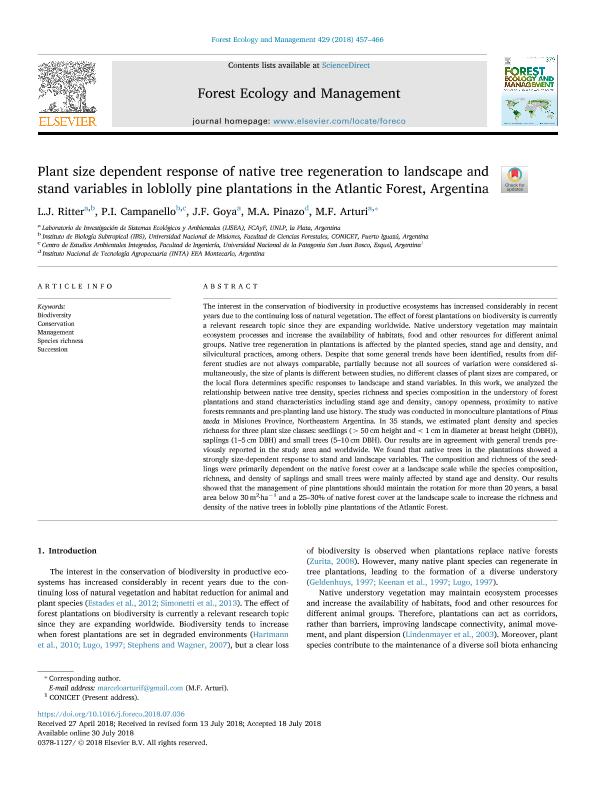Mostrar el registro sencillo del ítem
dc.contributor.author
Ritter, Luis Javier

dc.contributor.author
Campanello, Paula Inés

dc.contributor.author
Goya, Juan Francisco

dc.contributor.author
Pinazo, Martín Alcides

dc.contributor.author
Arturi, Marcelo Fabian

dc.date.available
2022-11-17T13:33:22Z
dc.date.issued
2018-12
dc.identifier.citation
Ritter, Luis Javier; Campanello, Paula Inés; Goya, Juan Francisco; Pinazo, Martín Alcides; Arturi, Marcelo Fabian; Plant size dependent response of native tree regeneration to landscape and stand variables in loblolly pine plantations in the Atlantic Forest, Argentina; Elsevier Science; Forest Ecology and Management; 429; 12-2018; 457-466
dc.identifier.issn
0378-1127
dc.identifier.uri
http://hdl.handle.net/11336/178182
dc.description.abstract
The interest in the conservation of biodiversity in productive ecosystems has increased considerably in recent years due to the continuing loss of natural vegetation. The effect of forest plantations on biodiversity is currently a relevant research topic since they are expanding worldwide. Native understory vegetation may maintain ecosystem processes and increase the availability of habitats, food and other resources for different animal groups. Native tree regeneration in plantations is affected by the planted species, stand age and density, and silvicultural practices, among others. Despite that some general trends have been identified, results from different studies are not always comparable, partially because not all sources of variation were considered simultaneously, the size of plants is different between studies, no different classes of plant sizes are compared, or the local flora determines specific responses to landscape and stand variables. In this work, we analyzed the relationship between native tree density, species richness and species composition in the understory of forest plantations and stand characteristics including stand age and density, canopy openness, proximity to native forests remnants and pre-planting land use history. The study was conducted in monoculture plantations of Pinus taeda in Misiones Province, Northeastern Argentina. In 35 stands, we estimated plant density and species richness for three plant size classes: seedlings (>50 cm height and <1 cm in diameter at breast height (DBH)), saplings (1–5 cm DBH) and small trees (5–10 cm DBH). Our results are in agreement with general trends previously reported in the study area and worldwide. We found that native trees in the plantations showed a strongly size-dependent response to stand and landscape variables. The composition and richness of the seedlings were primarily dependent on the native forest cover at a landscape scale while the species composition, richness, and density of saplings and small trees were mainly affected by stand age and density. Our results showed that the management of pine plantations should maintain the rotation for more than 20 years, a basal area below 30 m2·ha−1 and a 25–30% of native forest cover at the landscape scale to increase the richness and density of the native trees in loblolly pine plantations of the Atlantic Forest.
dc.format
application/pdf
dc.language.iso
eng
dc.publisher
Elsevier Science

dc.rights
info:eu-repo/semantics/openAccess
dc.rights.uri
https://creativecommons.org/licenses/by-nc-sa/2.5/ar/
dc.subject
BIODIVERSITY
dc.subject
CONSERVATION
dc.subject
MANAGEMENT
dc.subject
SPECIES RICHNESS
dc.subject
SUCCESSION
dc.subject.classification
Ecología

dc.subject.classification
Ciencias Biológicas

dc.subject.classification
CIENCIAS NATURALES Y EXACTAS

dc.title
Plant size dependent response of native tree regeneration to landscape and stand variables in loblolly pine plantations in the Atlantic Forest, Argentina
dc.type
info:eu-repo/semantics/article
dc.type
info:ar-repo/semantics/artículo
dc.type
info:eu-repo/semantics/publishedVersion
dc.date.updated
2022-11-16T11:45:26Z
dc.journal.volume
429
dc.journal.pagination
457-466
dc.journal.pais
Países Bajos

dc.journal.ciudad
Amsterdam
dc.description.fil
Fil: Ritter, Luis Javier. Consejo Nacional de Investigaciones Científicas y Técnicas; Argentina. Universidad Nacional de La Plata. Facultad de Ciencias Agrarias y Forestales. Laboratorio de Investigación de Sistemas Ecológicos y Ambientales; Argentina. Universidad Nacional de Misiones. Facultad de Ciencias Forestales. Instituto de Biología Subtropical - Sede Puerto Iguazú; Argentina
dc.description.fil
Fil: Campanello, Paula Inés. Consejo Nacional de Investigaciones Científicas y Técnicas; Argentina. Universidad Nacional de Misiones. Facultad de Ciencias Forestales. Instituto de Biología Subtropical - Sede Puerto Iguazú; Argentina. Universidad Nacional de la Patagonia "San Juan Bosco". Facultad de Ingeniería - Sede Esquel. Centro de Estudios Ambientales Integrados; Argentina
dc.description.fil
Fil: Goya, Juan Francisco. Consejo Nacional de Investigaciones Científicas y Técnicas; Argentina. Universidad Nacional de La Plata. Facultad de Ciencias Agrarias y Forestales. Laboratorio de Investigación de Sistemas Ecológicos y Ambientales; Argentina
dc.description.fil
Fil: Pinazo, Martín Alcides. Instituto Nacional de Tecnología Agropecuaria. Centro Regional Misiones. Estación Experimental Agropecuaria Montecarlo; Argentina
dc.description.fil
Fil: Arturi, Marcelo Fabian. Universidad Nacional de La Plata. Facultad de Ciencias Agrarias y Forestales. Laboratorio de Investigación de Sistemas Ecológicos y Ambientales; Argentina
dc.journal.title
Forest Ecology and Management

dc.relation.alternativeid
info:eu-repo/semantics/altIdentifier/doi/https://www.sciencedirect.com/science/article/pii/S0378112718307916
dc.relation.alternativeid
info:eu-repo/semantics/altIdentifier/doi/http://dx.doi.org/10.1016/j.foreco.2018.07.036
Archivos asociados
